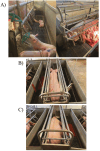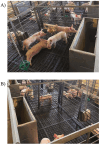Impact of farrowing crate enrichment strategies on the welfare and performance of sows, suckling piglets, and post-weaned piglets
- PMID: 40598811
- PMCID: PMC12272055
- DOI: 10.1093/jas/skaf196
Impact of farrowing crate enrichment strategies on the welfare and performance of sows, suckling piglets, and post-weaned piglets
Abstract
In conventional pig production, lactating sows are typically housed in farrowing crates that restrict movement and environmental engagement, raising welfare concerns. Farrowing pens also lack behavioral stimulation for suckling piglets, hindering species-specific behaviors. Environmental enrichment may improve welfare by redirecting behaviors-such as chewing-away from conspecifics in piglets and pen fixtures in sows. However, few studies have explored its effects in farrowing crates, particularly regarding optimal placement within these spatial constraints. This study evaluated the impacts of enrichment strategies on the welfare and performance of 37 lactating sows and their litters from birth through early post-weaning. Sows and litters were divided into three groups: both had access to enrichments (SPE), only piglets had access (PE), and a control group with no enrichments (CON). Point-source objects (PorkyPlays and wooden blocks on rope) were placed 2 d after sows moved into farrowing crates until 2 wk post-weaning. Sow salivary cortisol was collected at four timepoints, and pressure sores were assessed at 8 timepoints from 24 h after crate entry to weaning. Piglet tear stains and skin lesions were recorded throughout the lactation phase. Suckling piglet average daily gain (ADG) was analyzed at days 1 to 7, 7 to 14, and 14 to weaning. In the nursery, salivary cortisol, tear stains, and skin lesions were measured on days 1, 7, and 14 post-weaning, with an additional cortisol sample at day 0 post-weaning. Nursery piglet ADG was analyzed from weaning to day 14 post-weaning. CON sows were more likely to have a pressure sore compared to SPE sows (P = 0.02); PE sows tended to have a higher likelihood of developing a pressure sore than SPE sows (P = 0.097). No treatment effect was found for salivary cortisol of sows or nursery piglets. However, CON piglets had the largest tear stains during lactation (P < 0.001) and nursery (P = 0.001). Treatment affected piglet skin lesions during lactation, with CON piglets having more ear (P < 0.001) and front (P = 0.002) lesions and a higher overall lesion score (P < 0.0001). No treatment effect was found for ADG, piglet crushing, or nursery skin lesions. In conclusion, enrichment strategies in farrowing crates improved piglet skin health and tear stains without affecting performance. Enrichment access for sows tended to reduce pressure sores, suggesting enrichments can enhance welfare in farrowing crate systems.
Keywords: environmental enrichment; farrowing crates; pig welfare; skin lesions; tear stains.
Plain language summary
Sows on commercial farms are often housed in farrowing crates from a few days before farrowing until weaning to prevent piglet crushing and ease management. However, concerns are growing about the impact of these crates on piglet and sow welfare. Farrowing crates restrict sows’ movements, and piglets may develop abnormal oral manipulation behaviors due to a lack of environmental stimulation. Therefore, solutions are needed to improve welfare in these systems. Environmental enrichment could be beneficial, but information is needed to guide the optimal placement thereof in farrowing crates. This study tested whether different enrichment strategies affect welfare (cortisol levels, tear stains, skin lesions, and pressure sores) and performance (average daily gain and piglet crushing) of sows and piglets. Sows and piglets were divided into three groups: both had access to enrichments, only piglets had access, and a control group with no enrichments. Sows with enrichments tended to have fewer pressure sores, and piglets in both enriched groups had smaller tear stains during lactation and nursery, and fewer skin lesions during lactation, than those without enrichment. Enrichments did not affect cortisol levels, nursery skin lesions, or any performance measures. Overall, providing enrichments in farrowing crates may improve piglet and sow welfare.
© The Author(s) 2025. Published by Oxford University Press on behalf of the American Society of Animal Science.
Conflict of interest statement
The authors declare that they have no conflict of interest, financial or otherwise. Mention of trade names or commercial products in this article is solely for the purpose of providing specific information and does not imply recommendation or endorsement by the U.S. Department of Agriculture. All opinions expressed in this paper are the authors’ and do not necessarily reflect the policies and views of the USDA. The USDA is an equal opportunity lender, provider, and employer.
Figures






Similar articles
-
Effects of a preweaning socialization system on piglet livability, lifetime growth performance, and subsequent sow performance.J Anim Sci. 2025 Jan 4;103:skae385. doi: 10.1093/jas/skae385. J Anim Sci. 2025. PMID: 39708313
-
Effect of yeast probiotics in lactation and yeast cell wall prebiotic and Bacillus subtilis probiotic in nursery on lifetime growth performance, immune response, and carcass characteristics.J Anim Sci. 2024 Jan 3;102:skae320. doi: 10.1093/jas/skae320. J Anim Sci. 2024. PMID: 39432555
-
Colostrum and milk production in sows housed in free-farrowing versus crated systems under tropical conditions: Associations with sow metabolic state, oxidative stress, and piglet survival.Theriogenology. 2025 Nov;247:117572. doi: 10.1016/j.theriogenology.2025.117572. Epub 2025 Jul 9. Theriogenology. 2025. PMID: 40652738
-
The Black Book of Psychotropic Dosing and Monitoring.Psychopharmacol Bull. 2024 Jul 8;54(3):8-59. Psychopharmacol Bull. 2024. PMID: 38993656 Free PMC article. Review.
-
Treatments for breast engorgement during lactation.Cochrane Database Syst Rev. 2016 Jun 28;2016(6):CD006946. doi: 10.1002/14651858.CD006946.pub3. Cochrane Database Syst Rev. 2016. Update in: Cochrane Database Syst Rev. 2020 Sep 18;9:CD006946. doi: 10.1002/14651858.CD006946.pub4. PMID: 27351423 Free PMC article. Updated.
References
-
- Anderson, N. C. 2023. 75 deep dive into animal welfare measurements in swine and their implications. J. Anim. Sci. 101:10–11. doi: https://doi.org/ 10.1093/jas/skad341.011 - DOI
-
- Barnett, J. L., Hemsworth P. H., Cronin G. M., Jongman E. C., and Hutson G. D... 2001. A review of the welfare issues for sows and piglets in relation to housing. Aust. J. Agric. Res. 52:1–28. doi: https://doi.org/ 10.1071/ar00057 - DOI
-
- Baxter, E. M., Andersen I. L., , and Edwards, S. A.. 2018. Sow welfare in the farrowing crate and alternatives. In: Spinka, M., editor.. Advances in pig welfare. Cambridge (MA): Woodhead Publishing; p. 27–72. doi: https://doi.org/ 10.1016/B978-0-08-101012-9.00002-2 - DOI
-
- Beattie, V. E., Connell N. E. O., and Moss B. W... 2000. Influence of environmental enrichment on the behaviour, performance and meat quality of domestic pigs. Livest. Prod. Sci. 65:71–79. doi: 10.1016/S0301-6226(99)00179-7 - DOI
-
- Blackshaw, J. K., and Blackshaw A. W... 1989. Limitations of salivary and blood cortisol determinations in pigs. Vet. Res. Commun. 13:265–271. doi: https://doi.org/ 10.1007/BF00420834 - DOI - PubMed
MeSH terms
Substances
LinkOut - more resources
Full Text Sources

